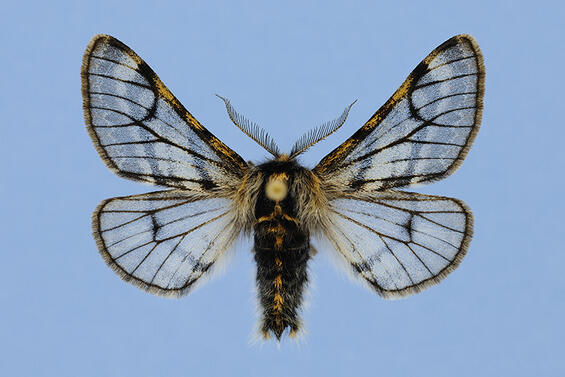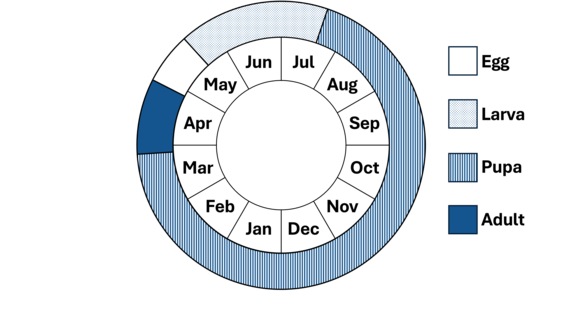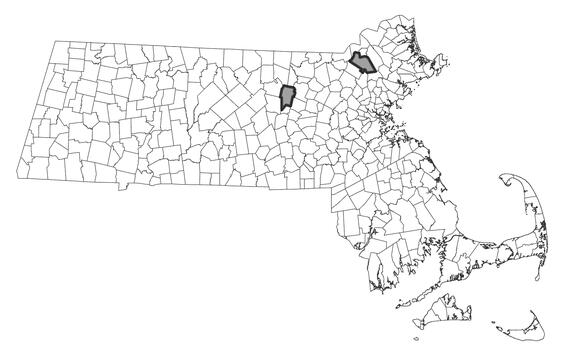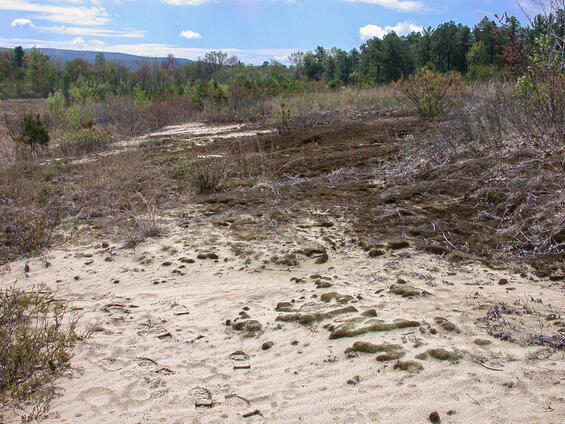- Scientific name: Lycia rachelae
- Species of Greatest Conservation Need (MA State Wildlife Action Plan)
- Endangered (MA Endangered Species Act)
Description

Twilight moth (Lycia rachelae)
The twilight moth (Lycia rachelae) is a geometrid moth with a wingspan of 30-37 mm (1.2-1.5 in) in the male (McGuffin 1977); the wings of the female are nonfunctional, rudimentary buds. In the male, both the forewing and hind wing are translucent with faint bands of white scales, and black scales prominently outlining the wing veins. On the forewing, the costal margin is black with orange patches, and the inner margin is black with white patches. The postmedial, median, and antemedial lines are wide, but faint and diffuse black bands. The reniform spot is reduced to a crescent-shaped concentration of black scales at the apex of the discal cell. On the hind wing, the postmedial line is a wide, but faint and diffuse black band, and the discal spot is a crescent-shaped concentration of black scales at the apex of the discal cell. In both sexes, the body is densely “hairy” (covered with elongate, hair-like scales), black in color with the longest “hairs” gray and tan; and with a dorsal orange stripe running from the head, across the thorax, and along the length of the abdomen.
Life cycle and behavior

Male twilight moths fly at dusk, and for a couple hours after, on evenings following the first relatively warm days of spring. In Massachusetts, such days typically occur in late March and April. Females ascend shrub and tree trunks and emit pheromone, waiting for males to find them by scent. Eggs are laid on a variety of shrubs and trees, with an apparent preference for poplars (Populus) and willows (Salix), but also birches (Betula), elms (Ulmus), and hazelnuts (Corylus) (Farquhar 1934). Eggs hatch two to four weeks after oviposition (McGuffin 1977), and larvae begin feeding on buds and new growth of the host plant. Larval development is slow, with larvae feeding for up to two months before pupating. Pupae overwinter.
Distribution and abundance
The major portion of the twilight moth’s range is in Canada, from Quebec west to British Columbia, and at high elevation in the Rocky Mountains of the western U.S., south to Colorado (McGuffin 1977, Schweitzer et al. 2011). The twilight moth is a boreal species, with rare and localized populations in northeastern Pennsylvania, Massachusetts, New Hampshire, and Maine. In Massachusetts, this species is only known from two sites in the northeastern part of the state.

Distribution in Massachusetts.
2000-2025
Based on records in the Natural Heritage Database.
Habitat
In Massachusetts, the twilight moth inhabits sandplain pitch pine-scrub oak barrens, as well as other shrublands and woodlands on sandy soils.
Healthy habitats are vital for supporting native wildlife and plants. Explore habitats and learn about conservation and restoration in Massachusetts.

Open sandplain barrens with shrubs and sapling trees, ideal habitat for the twilight moth.
Threats
The twilight moth is threatened by habitat loss and fire suppression in its disturbance-dependent habitats, in particular sandplain pitch pine-scrub oak barrens. Other potential threats include introduced generalist parasitoids, aerial insecticide spraying, non-target herbicide application, and off-road vehicles. A warming climate will likely be detrimental to the twilight moth, as it is a boreal species with rare and localized populations in northeastern Pennsylvania, Massachusetts, New Hampshire, and Maine, all isolated relicts from the period following retreat of Pleistocene glaciers.
Conservation
Land protection and habitat management are the primary conservation needs of this species in Massachusetts. In particular, sandplain pitch pine-scrub oak barrens should be conserved, restored, and managed to maintain habitat for this species and the entire suite of rare and threatened species dependent on such habitats.
Survey and monitoring
The distribution of the twilight moth in Massachusetts is relatively well documented, though somewhat less than some species due to its early spring flight season. Known populations of this species should be surveyed to document persistence at least once every 25 years; every 10 years is more desirable when practicable.
Management
Management of sandplain pitch pine-scrub oak barrens benefits a suite of rare and threatened species, and habitat condition should be monitored and management adapted as needed. For the twilight moth, open barrens with a shrub layer and scattered, sapling trees are of particular importance.
Research needs
The natural history and conservation needs of the twilight moth are not well understood. In particular, the specific larval host plants used in Massachusetts are not known. In addition, the future effects of a warming climate on this species will likely be detrimental, and this should be monitored and documented.
References
Farquhar, D.W. 1934. The Lepidoptera of New England. Ph.D. dissertation. Harvard University, Cambridge, Massachusetts. 328 pp.
McGuffin, W.C. 1977. Guide to the Geometridae of Canada (Lepidoptera). Volume II. Subfamily Ennominae, part 2. Memoirs of the Entomological Society of Canada No. 101: 1-191.
Schweitzer, D.F., M.C. Minno, and D.L. Wagner. 2011. Rare, Declining, and Poorly Known Butterflies and Moths (Lepidoptera) of Forests and Woodlands in the Eastern United States. Forest Service, U.S. Dept. of Agriculture, Washington, DC. 517 pp.
Contact
| Date published: | March 7, 2025 |
|---|